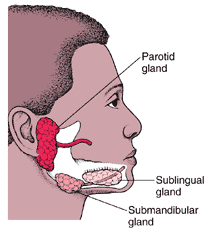I just saw a 5 year old boy with swelling in the angle of the jaw with mild pain
I became a bit confused since I was not sure if the kid had Mumps or cervical Lymphadenopathy.
Here is what I found on reading about it... I guess this is basic information, but I was challenged by this case.
 Nonspecific prodromal symptoms may precede parotitis by several days, including low-grade fever which may last three to four days, myalgia, anorexia, malaise, and headache. Fever may persist for 3 to 4 days. Parotitis, lasts at least 2 days, but may persist longer than 10 days. However, mumps infection may present only with nonspecific or primarily respiratory symptoms, or may be asymptomatic.
Nonspecific prodromal symptoms may precede parotitis by several days, including low-grade fever which may last three to four days, myalgia, anorexia, malaise, and headache. Fever may persist for 3 to 4 days. Parotitis, lasts at least 2 days, but may persist longer than 10 days. However, mumps infection may present only with nonspecific or primarily respiratory symptoms, or may be asymptomatic.
In my case, after reading up, I felt that the swelling was behind the angle of the jaw and I was able to feel the angle of the jaw, PLUS because the child was vaccinated, Mumps was less likely.
On the other hand, there is a hint of swelling appearing on the other side as well, and there is no other obvious focus, meaning that Mumps cannot be ruled out too.
So I have begun anti inflammatory, and kept Antibiotics on an as needed basis if the symptoms worsen.
I became a bit confused since I was not sure if the kid had Mumps or cervical Lymphadenopathy.
Here is what I found on reading about it... I guess this is basic information, but I was challenged by this case.
The Virus
Mumps is a viral illness caused by a paramyxovirus, a member of the Rubulavirus family. The average incubation period for mumps is 16 to 18 days, with a range of 12 to 25 days.
Clinical Features
Mumps usually involves pain, tenderness, and swelling in one or both parotid salivary glands (cheek and jaw area). Swelling is first visible in front of the lower part of the ear. It then extends downward and forward as fluid builds up in the skin and soft tissue of the face and neck. Swelling usually peaks in 1 to 3 days and then subsides during the next week. The swollen tissue pushes the angle of the ear up and out. As swelling worsens, the angle of the jawbone below the ear is no longer visible. Often, the jawbone cannot be felt because of swelling of the parotid. One parotid may swell before the other, and in 25% of patients, only one side swells. Other salivary glands (submandibular and sublingual) under the floor of the mouth also may swell but do so less frequently (10%).
 Nonspecific prodromal symptoms may precede parotitis by several days, including low-grade fever which may last three to four days, myalgia, anorexia, malaise, and headache. Fever may persist for 3 to 4 days. Parotitis, lasts at least 2 days, but may persist longer than 10 days. However, mumps infection may present only with nonspecific or primarily respiratory symptoms, or may be asymptomatic.
Nonspecific prodromal symptoms may precede parotitis by several days, including low-grade fever which may last three to four days, myalgia, anorexia, malaise, and headache. Fever may persist for 3 to 4 days. Parotitis, lasts at least 2 days, but may persist longer than 10 days. However, mumps infection may present only with nonspecific or primarily respiratory symptoms, or may be asymptomatic. Mumps infection is most often confused with swelling of the lymph nodes of the neck. Lymph node swelling can be differentiated by the well-defined borders of the lymph nodes, their location behind the angle of the jawbone, and lack of the ear protrusion or obscuring of the angle of the jaw, which are characteristics of mumps.
People with mumps are usually considered most infectious for several days before and after onset of parotitis. Source
Mumps. The swelling of mumps parotitis crosses the angle of the jaw. On the other hand, cervical lymph nodes are usually below the mandible (Leung & Robson, 1991). Source
In my case, after reading up, I felt that the swelling was behind the angle of the jaw and I was able to feel the angle of the jaw, PLUS because the child was vaccinated, Mumps was less likely.
On the other hand, there is a hint of swelling appearing on the other side as well, and there is no other obvious focus, meaning that Mumps cannot be ruled out too.
So I have begun anti inflammatory, and kept Antibiotics on an as needed basis if the symptoms worsen.